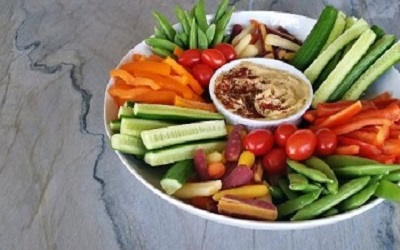When it comes to appetizers that are as visually stunning as they are delicious, a Hummus and Veggie Platter stands out as a timeless favorite. This simple yet sophisticated dish is the perfect balance of health, flavor, and creativity. Whether you’re hosting a dinner party, preparing for a casual gathering, or simply treating yourself to a nutritious snack, this platter promises to impress. Let’s explore why a hummus and veggie platter should be your go-to option and how to make it truly exceptional.
Why Choose a Hummus and Veggie Platter?
1. Healthy and Nutritious
Hummus, made from chickpeas, tahini, olive oil, lemon juice, and garlic, is a powerhouse of nutrients. It’s rich in protein, fiber, and healthy fats, making it a guilt-free indulgence. Paired with fresh, colorful veggies, this platter offers a variety of vitamins and minerals that cater to almost every dietary preference.
2. Versatility
A hummus and veggie platter can be tailored to suit different palates. From traditional hummus to variations like roasted red pepper or beet hummus, the possibilities are endless. Likewise, the choice of vegetables—from crunchy carrots and cucumbers to sweet bell peppers and cherry tomatoes—ensures there’s something for everyone.
3. Aesthetic Appeal
Let’s face it: a beautifully arranged platter is Instagram-worthy. The vibrant colors of fresh vegetables combined with the creamy texture of hummus create a feast for the eyes as well as the taste buds.
4. Ease of Preparation
Unlike many appetizers that require extensive cooking, a hummus and veggie platter can be assembled in minutes. With a bit of thoughtful arrangement, it looks like you’ve put in hours of effort.
How to Build the Perfect Hummus and Veggie Platter
Creating a standout hummus and veggie platter isn’t just about placing items on a plate. It’s an art form. Follow these steps to make your platter truly shine:
1. Choose Your Hummus
Start with one or more varieties of hummus. Here are some options to consider:
- Classic Hummus: The traditional choice with a creamy, nutty flavor.
- Roasted Red Pepper Hummus: Adds a smoky sweetness to the mix.
- Beet Hummus: Bright pink and slightly earthy, it’s a visual and flavorful treat.
- Avocado Hummus: Combines the creaminess of avocado with the richness of hummus.
- Spicy Hummus: Perfect for those who enjoy a bit of heat.
2. Pick a Variety of Vegetables
The key to a great platter is diversity. Include an assortment of textures, colors, and flavors. Some popular choices include:
- Crunchy Veggies: Carrots, celery, radishes, and bell peppers.
- Juicy Options: Cherry tomatoes, cucumber slices, or snap peas.
- Roasted Veggies: Zucchini, sweet potato wedges, or asparagus for a unique touch.
- Exotic Choices: Jicama sticks, rainbow carrots, or purple cauliflower for added flair.
3. Add Complementary Dippers
While vegetables are the star, adding a few extras can elevate your platter:
- Pita Bread: Cut into triangles or baked into chips.
- Crackers: Whole grain or seeded varieties work best.
- Breadsticks: A crunchy alternative.
4. Include Garnishes and Extras
Small additions can make a big difference:
- Olives: Kalamata or green olives add a salty, briny flavor.
- Pickles: Gherkins or pickled vegetables bring a tangy twist.
- Nuts: Roasted almonds or cashews add crunch and richness.
- Herbs: Fresh parsley, cilantro, or dill for a pop of color and freshness.
5. Arrange Thoughtfully
Presentation is everything. Use a large platter or board and arrange your items in sections or clusters. Place the hummus bowls in the center and surround them with vegetables and dippers. For added visual appeal, overlap colors and textures to create a dynamic look.
Tips for an Outstanding Platter
- Use Seasonal Produce: Incorporate vegetables that are in season for the freshest flavors.
- Keep It Balanced: Mix sweet, savory, and tangy elements to keep things interesting.
- Make It Interactive: Serve with small spoons or tongs to allow guests to customize their bites.
- DIY Hummus: Homemade hummus often tastes fresher and can be customized to your liking. Simply blend chickpeas, tahini, olive oil, garlic, and lemon juice in a food processor.
Variations to Try
- Mediterranean-Style Platter Add falafel, stuffed grape leaves, and feta cheese to give your platter a Mediterranean twist.
- Mexican-Inspired Platter Include guacamole, salsa, and tortilla chips alongside your hummus and veggies.
- Vegan Cheese Platter Incorporate plant-based cheese slices and spreads for an all-vegan option.
- Sweet and Savory Platter Pair your hummus with fruits like apple slices, grapes, or dried apricots for a unique flavor combination.
Why It’s Perfect for Any Occasion
A hummus and veggie platter fits seamlessly into any event, from casual picnics to elegant dinner parties. Its versatility means it can serve as a starter, a side dish, or even the main attraction for lighter gatherings. Plus, it’s an excellent option for accommodating dietary restrictions, as it’s naturally vegetarian, and gluten-free dippers can be easily incorporated.
Final Thoughts
A Hummus and Veggie Platter is more than just an appetizer; it’s a statement of simplicity, health, and creativity. By thoughtfully selecting and arranging your ingredients, you can create a dish that’s not only delicious but also visually stunning. So, the next time you’re looking for an appetizer that’s easy to prepare, universally loved, and endlessly customizable, let the hummus and veggie platter take center stage.

